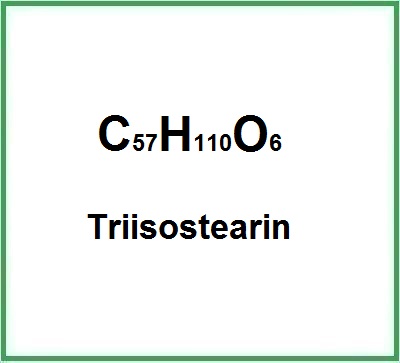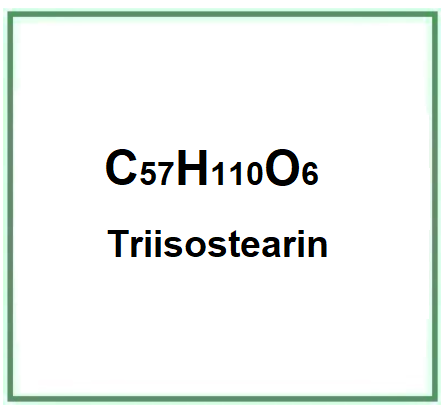Triisostearin was considered safe for human health by the Cosmetic Ingredient Review Panel expert group (1).
References_____________________________________________________________
(1) Johnson W Jr; Cosmetic Ingredient Review Expert Panel. Final report on the safety assessment of trilaurin, triarachidin, tribehenin, tricaprin, tricaprylin, trierucin, triheptanoin, triheptylundecanoin, triisononanoin, triisopalmitin, triisostearin, trilinolein, trimyristin, trioctanoin, triolein, tripalmitin, tripalmitolein, triricinolein, tristearin, triundecanoin, glyceryl triacetyl hydroxystearate, glyceryl triacetyl ricinoleate, and glyceryl stearate diacetate. Int J Toxicol. 2001;20 Suppl 4:61-94.
Abstract. Triesters of glycerin and aliphatic acids, known generically as glyceryl triesters and specifically as Trilaurin, etc., are used in cosmetic products as occlusive skin-conditioning agents and/or nonaqueous viscosity-increasing agents. Hundreds of glyceryl triesters are used in a wide variety of cosmetic products at concentrations ranging from a few tenths of a percent to 46%. Glyceryl triesters are also known as triglycerides; ingested triglycerides are metabolized to monoglycerides, free fatty acids, and glycerol, all of which are absorbed in the intestinal mucosa and undergo further metabolism. Dermal absorption of Triolein in mice was nil; the oil remained at the application site. Only slight absorption was seen in guinea pig skin. Tricaprylin and other glyceryl triesters have been shown to increase the skin penetration of drugs. Little or no acute, subchronic, or chronic oral toxicity was seen in animal studies unless levels approached a significant percentage of caloric intake. Subcutaneous injections of Tricaprylin in rats over a period of 5 weeks caused a granulomatous reaction characterized by oil deposits surrounded by macrophages. Dermal application was not associated with significant irritation in rabbit skin. Ocular exposures were, at most, mildly irritating to rabbit eyes. No evidence of sensitization or photosensitization was seen in a guinea pig maximization test. Most of the genotoxicity test systems were negative. Tricaprylin, Trioctanoin, and Triolein have historically been used as vehicles in carcinogenicity testing of other chemicals. In one study, subcutaneous injection of Tricaprylin in newborn mice produced more tumors in lymphoid tissue than were seen in untreated animals, whereas neither subcutaneous or intraperitoneal injection in 4- to 6-week-old female mice produced any tumors in another study. Trioctanoin injected subcutaneously in hamsters produced no tumors. Trioctanoin injected intraperitoneally in pregnant rats was associated with an increase in mammary tumors in the offspring compared to that seen in offspring of untreated animals, but similar studies in pregnant hamsters and rabbits showed no tumors in the offspring. One study of Triolein injected subcutaneously in rats showed no tumors at the injection site. As part of an effort to evaluate vehicles used in carcinogenicity studies, the National Toxicology Program conducted a 2-year carcinogenicity study in rats given Tricaprylin by gavage. This treatment was associated with a statistically significant dose-related increase in pancreatic acinar cell hyperplasia and adenoma, but there were no acinar carcinomas, the incidence of mononuclear leukemia was less, and nephropathy findings were reduced, all compared to corn oil controls. Overall, the study concluded that Tricaprylin did not offer significant advantages over corn oil as vehicles in carcinogenicity studies. Trilaurin was found to inhibit the formation of neoplasms initiated by dimethylbenzanthracene (DMBA) and promoted by croton oil. Tricaprylin was not teratogenic in mice or rats, but some reproductive effects were seen in rabbits. A low level of fetal eye abnormalities and a small percentage of abnormal sperm were reported in mice injected with Trioctanoin as a vehicle control. Clinical tests of Trilaurin at 36.3% in a commercial product applied to the skin produced no irritation reactions. Trilaurin, Tristearin, and Tribehenin at 40%, 1.68%, and 0.38%, respectively, in commercial products were also negative in repeated-insult patch tests. Tristearin at 0.32% in a commercial product induced transient, mild to moderate, ocular irritation after instillation into the eyes of human subjects. Based on the enhancement of penetration of other chemicals by skin treatment with glyceryl triesters, it is recommended that care be exercised in using them in cosmetic products. On the basis of the available data, the following 23 glyceryl triesters are considered safe as used in cosmetics: Trilaurin, Triarachidin, Tribehenin, Tricaprin, Tricaprylin, Trierucin, Triheptanoin, Triheptylundecanoin, Triisononanoin, Triisopalmitin, Triisostearin, Trilinolein, Trimyristin, Trioctanoin, Triolein, Tripalmitin, Tripalmitolein, Triricinolein, Tristearin, Triundecanoin, Glyceryl Triacetyl Hydroxystearate, Glyceryl Triacetyl Ricinoleate, and Glyceryl Stearate Diacetate. Some of these are not currently in use, but would be considered safe if used at concentrations similar to those glyceryl triesters that are in use as cosmetic ingredients.
![]() Glycerol triisostearate
Glycerol triisostearate 




